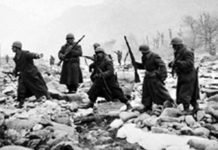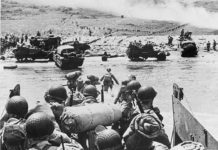The young Russian soldier who started out as a poet ended up creating one of the most enduring symbols of anti-Western ideology – the Kalashnikov rifle.
Few people carry a name that because of a single product becomes a universal logo for revolution and resistance. Mikhail Kalashnikov is one of those people, and the single product is his AK-47 assault rifle.
AK-47 — weapon and icon
The AK-47 has been called the world’s most prolific and effective combat weapon — one so simple and cheap that in some countries an insurgent can obtain one for the price of a live chicken. With its unique banana-shaped magazine, the rifle is recognizable everywhere, wielded equally by third-world armies, paramilitary groups, street gangs, and drug dealers.
Several countries have enshrined the gun on their flags, stamps and currency, and the name carries such mojo that children are named in its honor. In 2004, Playboy magazine named the AK-47 one of the “50 Products That Changed the World,” ranking it behind the Apple Macintosh desktop, the birth-control pill, and the Sony Betamax video machine.
During the Vietnam War, American soldiers reportedly culled enemy AKs to replace their more sophisticated but more sensitive M-16 rifles, which, unlike the ‘47s, often jammed under jungle fighting conditions.
And forever fused to the millennial images that appeared with the 911 attack is the famous video of a flowing-robed Osama bin Laden supplely handling and firing an AK-47 — the ultimate provocation to Western values and security.
Father of the AK-47
Mikhail Timofeyevich Kalashnikov was born November 10, 1919 into a farming family in Russia’s Southern Altai region. As a youth Kalashnikov wrote poetry, and the boy was expected to follow this calling.
However, Hitler’s invasion of the Russian motherland in 1941 put Kalashnikov’s writing on hold, and the young man instead found himself facing the Germans as a tank mechanic and commander in the Soviet army. During the battle for Bryansk in October 1941, “Misha” suffered a shoulder wound, and for the next six months was confined to an army hospital.
During his convalescence the 22-year old heard other soldiers complaining about the failings of their Soviet-issued rifles — especially against the German Sturmgewehr, 44 or “storm rifle,” the first of the modern assault rifles that combined the midrange abilities of a rifle with the close-quarters firepower of a machinegun, using a 7.92x33mm round. The Russians’ heavy machine guns, light submachine guns, and slow but accurate rifles matched up poorly.
With his own harrowing memories of the German onslaught still fresh, the young Kalashnikov decided to design an automatic rifle that combined the best features of the German StG44 and the American M1 Garand.
Kalashnikov would later say, “Blame the Nazi Germans for making me become a gun designer… I wanted to construct agriculture machinery.”
Drafting the perfect small arms design
From his hospital bed he began sketching a gun that was simple, elegant, rugged, and easy to keep and operate. Kalashnikov wanted to match the Sturmgewehr’s light weight and fast, automatic fire, but he was also thinking about Russian snow and mud and the soldiers who would have to clean, use, and maintain the gun under extreme conditions.
Neither the first nor even the third design proved the charm. Kalashnikov tried a dozen different modifications starting with a sub-machine gun and moving through several different models, including a carbine strongly influenced by the now classic American M1 Garand.
It wasn’t until 1947 that Kalashnikov and his team arrived at the design that started a legend: the Avtomat Kalashnikova, year 1947 or AK-47. It was a gas-operated rifle with a breech-block mechanism, similar to his earlier carbine, chambered in 7.62x39mm.
For a huge country like Russia, it proved a commander’s dream: cheap, reliable, effective, and simple enough that even the most backwater Siberian parenyok could learn to service and use it. The AK quickly became the standard rifle for all the Soviet armed forces.
Lethal simplicity
The fire power of Kalashnikov’s rifle proved extreme. Its heavy caliber small arms round could puncture body armor, and the weapon expelled a cycled rate of fire of 600 rounds per minute (RPM), with a practical sustained rate of fire of 90-100 RPM. The AK-47 usually came equipped with 30- round magazines.
While the weapon appeared too late to use against the Nazis, it was a standard Soviet army fixture by the time Khrushchev decided to quash the1956 Budapest uprising. In the gun’s first public campaign, Red Army soldiers extinguished thousands of Hungarian lives with the aid of the AK-47.
In the coming decades, the world would see more displays of the gun’s proficiency as Soviet governments sold and distributed millions of the weapon throughout Soviet block and third-world countries for use in Cold War proxy conflicts and other campaigns of liberation.
A Russian national brand copied globally
On Mikhail Kalashnikov’s ninetieth birthday in November 2009, President Dmitri Medvedev told him, “What you’ve done has made Russian weapons one of our best national brands. ‘Kalashnikov’ is one of the most famous Russian words.”
But the inventor, now approaching his 92 birthday, never patented his design and thus never gained any real earnings from the estimated 100 million AK-47 rifles in circulation. He lives modestly on a pension in Izhevsk, an industrial town 800 miles east of Moscow, where he still works four days a week as the chief weapons designer at Izhmash, the company that finally patented his rifle in 1997.
Meanwhile, factories in at least 30 countries across the world, including China, Poland, Bulgaria, Hungary, North Korea, Iran and Egypt, have been producing “counterfeit” Kalashnikov rifles. By 2006, Russia accounted for only 10 percent of the global production of AK-47s.
The Kalashnikov brand
In 1978, the Soviet Union began replacing their AK-47 with a smaller caliber design, the AK-74. The USSR had just begun exporting the new model and cartridge to Eastern European nations when history was made as the Soviet Union collapsed.
Some gun buffs rightly grouse that, among its drawbacks, the AK lacks accuracy, has dreadful recoil and noise, and shows an annoying tendency to lift its barrel during shooting.
But Kalashnikov’s design workshop gave life to a whole range of arms, from light machine guns to an underwater rifle to a sniper rifle. The former commander has designed more than 150 modifications of the assault rifle and other guns.
Because Kalashnikov never saw earnings from his creation, the inventor has since lent his brand name to and received royalties from a wide range of products, including Kalashnikov snowboards, umbrellas, shaving foam, watches, knives, and vodka.
Now an international eminence, Mr. Kalashnikov lives just a few blocks away from a museum dedicated to him and his weapons that welcomes 10,000 visitors a month. He continues to write, and has published six books. He loves classical music and finds pleasure in tinkering with designs for hunting rifles.
Mr. Kalashnikov does not apologize for the havoc inflicted by his creation, and seems most proud of his origins as a self-taught patriot who answered his homeland’s call as soldier and as General Designer of small arms in the Soviet army.
‘I’ve served my motherland and will continue … to the end of my days,” he said. “I created a weapon to defend the borders of my motherland. It’s not my fault that it’s being used where it shouldn’t be. The politicians are more to blame for this.”








